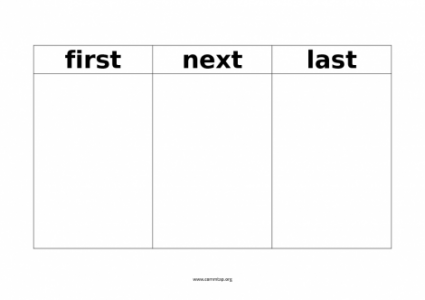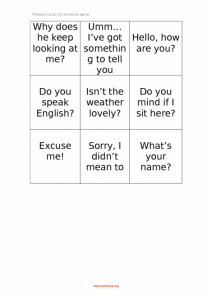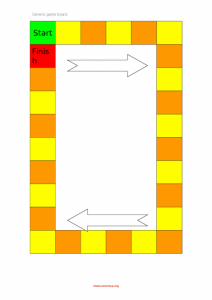Search
User login
Topic “Secondary (11-16yrs)”
Secondary school age (11-16 years)
Diagram of the Chute
Picture:

Picture description:
Diagram of the chute - a special kind of posting box.
Simple topic maintenance
| Activity/strategy name and materials required | How to do the activity | Key principles for doing the activity and comments |
|---|---|---|
| My interests |
| |
| Topic introduction
| ||
| Talk about it
| Optional:
| |
| Likes and dislikes Something to record the students responses on (e.g. paper/pen) which can later be used as a prompt; Soft ball or beanbag. | To make it harder, you can go around again asking for favourite drinks - so that everyone now has to remember a food and a drink for each student when they pass the ball (e.g "Tim - (you like) carrot cake and tea"). You could use favourite games, favourite places to go, etc. instead. | |
| What have you done today? Way of recording students responses - e.g. paper/pen, whiteboard/marker; Soft ball or beanbag. |
Select a picture on an eye gaze frame
| Activity/strategy name and materials required | How to do the activity | Key principles for doing the activity and comments |
|---|---|---|
| Picture pairs Plastic perspex sheet with hole in the middle, around 40cm x 30cm (e.g "E-tran frame"); Two sets of everyday picture cards - or whatever the student is interested in. |
| If the student has difficulties, you can try pointing it at each position on the frame - starting from their top left and working across and down - say "is it here" at each position ("no!") - until you get to the right position, say "yes" "here's the....". Say "look at the....", then ask them and say "where was the....?" - taking your eyes slowly to the position - trying to take the student's eyes with you. When you get there, take it off, pretend to eat it (for example) and then put it on the "done" pile with the other card. More ideas about this here from Call Scotland. Going further When a student can do this with one picture, try adding more pictures on the frame (distractor pictures). Start with two, then three/four (one on each corner), then gradually up to seven (each corner and the middle of each side except the bottom side. Put the target card - the one you are working on - in one of the positions you are using. |
| Find the picture/item Plastic perspex sheet with hole in the middle, around 40cm x 30cm (e.g "E-tran frame"); Two sets of everyday picture cards - or whatever the student is interested in. | If the student has difficulties, you can try pointing it at each position on the frame - starting from their top left and working across and down - say "is it here" at each position ("no!") - until you get to the right position, say "yes" "here's the....". Say "look at the....", then ask them and say "where was the....?" - taking your eyes slowly to the position - trying to take the student's eyes with you. When you get there, take it off, and pretend to eat it/drive it etc. More ideas about this here from Call Scotland. Going further When a student can do this with one picture, try adding more pictures on the frame (distractor pictures). Start with two, then three/four (one on each corner), working up to seven (each corner and the middle of each side except the bottom side. Put the target card - the one you are working on - in one of the positions you are using. | |
| Confirmation using a "special spot" Plastic perspex sheet with hole in the middle, around 40cm x 30cm (e.g "E-tran frame"); Two sets of everyday picture cards - or whatever the student is interested in. | The idea of this activity is for the student to learn how they can confirm a choice. It is necessary to have some way of them confirming a choice because:
All these will make it difficult to be sure what they are trying to communicate. The "special spot" (which could for example be a red circle stuck in the bottom middle of the frame) can be a point that a student to look to to:
|
Recall a sequence of three or more activities in the right order
| Activity/strategy name and materials required | How to do the activity | Key principles for doing the activity and comments |
|---|---|---|
| Recall what happened in a lesson The materials you had in the lesson. Picture prompts for the activities that were carried out. Piece of card to stick the prompts onto as you do the activities in the lesson. |
| You can work on recall of the main activities in the lesson, for example:
Strategies you could use if the student is finding this difficult: At the end of one activity say we were "listening", next we will draw a picture. Show a prompt card for each - so the student can see the progression from one activity to another. Ask them about these two activities at the end of the second one. |
Describe a practical activity having three or more steps
| Activity/strategy name and materials required | How to do the activity | Key principles for doing the activity and comments |
|---|---|---|
| Breakfast Breakfast food and implements, rough sketches or photos of each stage in the sequence to use as prompts. Ideas for sequences: Toast
Note: you can simplify the sequence - e.g. bread - toaster - spread butter. Or you could make it more complex. Make a cup of tea
As with the toast, you can simplify this or make it more complicated! |
| This activity incorporates some automatic feedback - if the student gets it wrong, then it will probably not work and they will need to correct themself. |
sequences three pictures showing a practical activity
| Activity/strategy name and materials required | How to do the activity | Key principles for doing the activity and comments |
|---|---|---|
| Practical sequences Camera to make the picture sequences (or alternatively you can draw them or use a commercial resource). Resources as appropriate to carry out a simple sequence Examples of sequences (with suggested steps to make pictures for): Putting on a jumper (get jumper, put head through, put arms through); Drinking a drink (jug and cup, pour water into the cup, drink it) Peeling and eating a piece of fruit (fruit, peel fruit, eat it) Sitting down and eating dinner Drawing a picture (pencil and paper, child drawing, finished picture) Looking at a book (get it, open it, look at it) | 1. Carry out the activity without the pictures; 2. Do it again, showing the relevant picture for each part of the activity as you do it; 3. Get the child to do the sequence, tell them what to do by showing them a picture for each part of the sequence; 4. Get them to show you what to do by giving you a picture for each part of the sequence. Try to do exactly as the picture you are given indicates, for example if they give you a picture of someone blowing bubbles without having given you the step for opening the bubbles container, try to blow the bubbles anyway (and act being disappointed when you don't get any bubbles). | At this level children may often be able to learn particular sequences of pictures without understanding that they relate to a sequence of actions, these activities are designed to address this issue. Seeing how the sequence goes wrong if the wrong picture is chosen (in step 4) will encourage the child to work out which should have been the right picture without you needing to give any further feedback. |
think and talk about events in the past and future
| Activity/strategy name and materials required | How to do the activity | Key principles for doing the activity and comments |
|---|---|---|
| Which day? Sheet of paper with 3 boxes drawn on them for yesterday, today and tomorrow. A counter. Optional: sets of symbol cards or pictures showing a variety of activities - including activities the student may have done. You can create symbols cards using the Commtap Symboliser for PowerPoint. | 1. Talk about each day, one at a time. Get the student to draw or write things they have done or will do in each box. Use the picture symbols if the student is having difficulty coming up with things. 2. When you have finished, explain that there is going to be a quiz. Describe an activity and the student must say if they did it yesterday, did it today or will do it tomorrow. 3. Have them step the counter over onto the right day. | This works best when there are key things which are different about each day! |
| The Story of Fred Set of three pictures - one showing a picture of a child, one showing a picture (preferably of the same person!) at a similar age to the student and one a picture of an older person. These could be photographs or drawings. Choose three ages which are appropriate/relevant for the student.
Large 'thought clouds ' on A3 or A4 paper: Sticky tape Pens Picture symbol prompts if required. You can create symbol prompts using the Commtap Symboliser for PowerPoint. | ||
| Calendar Calendar Pens | This is an ongoing activity. You could take photos of the key events, and put them on the calendar. | |
| Daily Schedule/Picture Schedule Any activity or set of activities where the student might use a schedule or have a visual timetable. You can create a visual timetable/schedule using the Commtap Symboliser for PowerPoint. |
Sequence three pictures related to hygiene
| Activity/strategy name and materials required | How to do the activity | Key principles for doing the activity and comments |
|---|---|---|
| Self Care Activities Camera to make the picture sequences (or alternatively you can draw them or use a commercial resource). Resources as appropriate to carry out a simple sequence Examples of sequences: Clean teeth: get toothpaste, open lid, get brush, squeeze toothpaste onto brush, put lid back onto toothpaste, brush teeth, spit out, put brush under water, repeat, clean brush, put brush away. Wash hands: turn on tap, rinse hands, put soap on hands, scrub hands, rinse under water, turn tap off, dry with towel. Brush hair: get brush, brush hair, put brush away. Deodorant: get deodorant, take off lid, spray at appropriate area, put lid back on, put away. | 1. Carry out the sequence without the pictures; 2. Do it again, showing the relevant picture for each part of the activity as you do it; 3. Get the student to do the sequence, showing them a picture for each part of the sequence as they do it; 4. Get them to show you what to do by giving you a picture for each part of the sequence. Try to do exactly as the picture you are given indicates, for example if they give you a picture of scrubbing your hands before the tap is turned on/before you have the soap, try to do this - but appear confused when this doesn't work. | At this level students may often be able to learn particular sequences of pictures without understanding that they relate to a sequence of actions, these activities are designed to address this issue. Seeing how the sequence goes wrong if the wrong picture is chosen (in step 4) will encourage the student to work out which should have been the right picture without you needing to give any further feedback. |
Think through more complex social situations
| Activity/strategy name and materials required | How to do the activity | Key principles for doing the activity and comments |
|---|---|---|
| Newspaper Newspaper or children's paper or magazine Large sheet of paper Pens | Choose a page of a newspaper or children's paper, or cut out some stories from a newspaper. (You could also do this on line if you have access to a computer. It is very motivating for the children!) Choose stories that will prompt discussion and are not simple right / wrong issues. Put the main person in the story in a circle in the middle of a page. Draw lots of lines out of the circle, and think of different things the person could do. Have each child circle the one they think they would suggest . Help the children think about what will happen if the person takes their advice. | |
| You're in charge! Cards to write situations on. Paper Pens | ||
| Freeze frames Short video clips from children's programmes | You could write individual or group letters to the programme makers suggesting an ending to this scene. | |
| Alien bluff Alien puppet or picture. Cards to write situations on. Everyday situations at school and home. | Use a variety of situations - in class, in whole school events, in the playground, at home, etc. | |
| Social Sequences LDA what's wrong social sequencing cards. Paper or whiteboard Pens | Use paper or a white board to keep the discussion focused. Use facial emotions cards as visual prompts to help the children think about what people are feeling and why. |
Share information about self with others
| Activity/strategy name and materials required | How to do the activity | Key principles for doing the activity and comments |
|---|---|---|
| Likes and dislikes Optional - something to record the students responses on (e.g. paper/pen) which can later be used as a prompt; Soft ball or beanbag. |
| To make it harder, you can go around again asking for favourite drinks - so that everyone now has to remember a food and a drink for each student when they pass the ball (e.g "Tim - you like carrot cake and tea"). You could use favourite games, favourite places to go, etc. instead. |
Talk about things in the recent past
| Activity/strategy name and materials required | How to do the activity | Key principles for doing the activity and comments |
|---|---|---|
| What have you done today? Optional - way of recording students responses - e.g. paper/pen, whiteboard/marker |
| Variations
|
| What have you done today - with a ball Optional - way of recording students responses - e.g. paper/pen, whiteboard/marker Soft ball or beanbag |
To make eye contact
| Activity/strategy name and materials required | How to do the activity | Key principles for doing the activity and comments |
|---|---|---|
| Gain visual attention Use something that the person may be visually attracted by, for example:
|
| Remember that although the room needs to have little visual distraction the light needs to be sufficient to allow clear eye contact to be made e.g. a low light sensory room may not be so good for this activity. |
First next last; first last templates
Template to use for first/next/last or first/last sequencing - with space for pictures. Example activities: sequences three pictures with first next and last.
Created 18 October 2012; updated 19 July 2015.
Phrases cards for emotions game
Created 18 October 2012; updated 30 April 2022.
Generic game track
A coloured track which, along with dice and counters for example, could be used to make a variety of activities into a game - for example, shake the dice, move the counter, and if you land on an orange square, pick a card and describe what is on it.
Created 18 October 2012; updated 19 July 2015.
Support Commtap to keep it online
Thank you for visiting Commtap.
Please read this message as it is extremely important.
- Visitor donations mean we can continue to host over 1,000 free activities to support speech, language, and communication development.
- Visitor donations mean we can continue to provide free resources to address a wide range of communication needs, including limited speech or language, interaction challenges, and needs associated with conditions such as developmental language disorder, autism, and cerebral palsy.
- Visitor donations mean we can continue to provide resources to support the work of speech and language therapists, teachers, teaching assistants, parents, and carers.
- Visitor donations mean we can continue to provide the free key word sign dictionary (bks.org.uk) which has over 2,000 Makaton and Signalong signs.
We know that not everyone is able to afford to pay to access these resources, however, if you can, please make a donation to keep the site going.
Thank you
Google ads on this page are provided by Google Adsense - and their presence does not imply any endorsement by Commtap. Report a problem with an ad on this page. Log in (for free) to avoid seeing Google ads.




